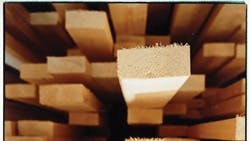Pneumatics gets lumber mills rolling
In the lumber industry, productivity demands are staggering; output is often measured in lugs per minute, a unit that describes how quickly a machine can process logs and boards. OEMs and timber-processing end users also need machines that can withstand harsh mill problems where temperatures fluctuate, dust damages equipment, and vibrations stress and grate machinery. Traditionally, heavy-duty steel pneumatic cylinders were the only long-lasting hardware used in lumber production. However, over the past few years, pneumatic solutions combined with lighter and less expensive aluminum have improved sawmill production.
Mills resisted using aluminum because failure of aluminum pneumatic cylinders was common on equipment such as trim saws, where high speed and shock overstressed the units. Even though aluminum cylinders are less expensive than steel, the steep cost of downtime made sawmill operators question their use. “Downtime in a mill is about $1,000 an hour,” says lumber industry consultant Bill Bowlin. “So if a trimmer stops for some reason, the whole mill stops because all the boards have to pass through the trimmer to get out of the mill.”
Now, a new combination of pneumatics, aluminum, and ideal cushioning increases cylinder longevity and performance. The latter is a solution developed by Bosch Rexroth Corp., Lexington, Ky., that gently decelerates the pneumatic piston as it reaches end of stroke inside the cylinder to eliminate bounce and end-cap slamming, two main culprits of cylinder wear. It is particularly useful for eliminating excess piston movement and bounce on quickly cycling, highly kinetic sawmills, especially in trim saws where pneumatic cylinders constantly drive blades up and down. Piston velocity — at its maximum speed throughout the stroke sequence — is exactly zero when it reaches the end cap. Vibration and noise are reduced and cycle time is improved, boosting machine speed as much as 30%. Cylinders with ideal cushioning are also lighter to further improve acceleration and cycle times.
Advanced Sawmill Machinery Equipment Inc. (ASM), Holt, Fla., worked with Bosch Rexroth to incorporate aluminum cylinders with ideal cushioning in its Series 140 Trimmer. The machine builder wanted to offer faster cycle rates and more durability. ASM president David Seffens says the cylinders make their high-speed trimmer competitive and play a big role in opening up the 140 to 200 lugs-per-minute market for ASM. Seffens also notes that all the saw ladder surfaces on the Series 140 Trimmers are machined, keyed, and require no alignment by the customer. With the aluminum cylinders, each machine is customized for speed at the request of the end user. For more information, visit www.boschrexroth-us.com.
